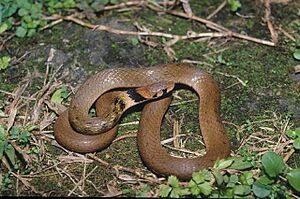Taiwan keelback facts for kids
The Taiwan keelback (Rhabdophis swinhonis) is a type of snake found only in Taiwan. It is also called Swinhoe's grass snake. This snake belongs to a group of snakes known as Colubridae, which is a very large family of snakes.
Quick facts for kids Taiwan keelback |
|
|---|---|
 |
|
| Conservation status | |
| Scientific classification | |
| Synonyms | |
|
Contents
Where Does Its Name Come From?
The snake's scientific name, swinhonis, honors a British explorer named Robert Swinhoe. He was a diplomat and a naturalist who worked in China in the 1800s. Mr. Swinhoe was the person who first found and collected this type of snake.
What Does the Taiwan Keelback Look Like?
The Taiwan keelback can grow up to 70 cm (28 in) long, which includes its tail. Its body is fairly strong, and its tail is a medium length.
Skin and Scales
This snake has 15 to 17 rows of special scales on its back. These scales are "keeled," meaning they have a ridge down the middle. The top of its body is dark grey-brown. It might have some black square-shaped marks that are not always clear.
Head and Eyes
The snake's head is oval-shaped. Its eyes are medium to large with a dark grey-brown iris. The pupil, which is the center of the eye, is round and very black. It has a grey ring around it.
Colors and Markings
The underside of the snake is a light cream or grey color. It has dark spots or patches. The top of its head is a uniform dark olive grey or olive brown. The sides of its head are lighter. You might see a black stripe below its eye. There is also a larger black stripe on the side of its head, near its mouth. A clear, thick black V-shape points backward on the back of its neck.
How Does It Defend Itself?
The Taiwan keelback is not venomous, meaning its bite is not harmful. It is also a very calm snake. If it feels threatened, it might flatten its throat and neck to look bigger. However, it is very unlikely to bite. This snake has special glands on its neck that can release a brown liquid. Scientists think this liquid might help scare away animals that want to eat it.
Reproduction and Life Cycle
The Taiwan keelback reproduces by laying eggs. This is called oviparity. Each time a female snake lays eggs, she can lay between 6 and 15 eggs.
Where Does the Taiwan Keelback Live?
This snake lives all over Taiwan. You can find it in places that are 500–1,000 m (1,600–3,300 ft) above sea level. It is active during the day, which means it is a diurnal snake. It likes to live on the forest floor, in bushy areas, and other places that are humid. You might also see them in farm fields.
What Does It Eat?
The main food for the Taiwan keelback is frogs. They are predators that hunt frogs for their meals.
Is the Taiwan Keelback in Danger?
The Taiwan keelback is not a very common snake. However, it is not currently facing big threats to its survival. It lives in protected areas and has a special protection status called Class III.


